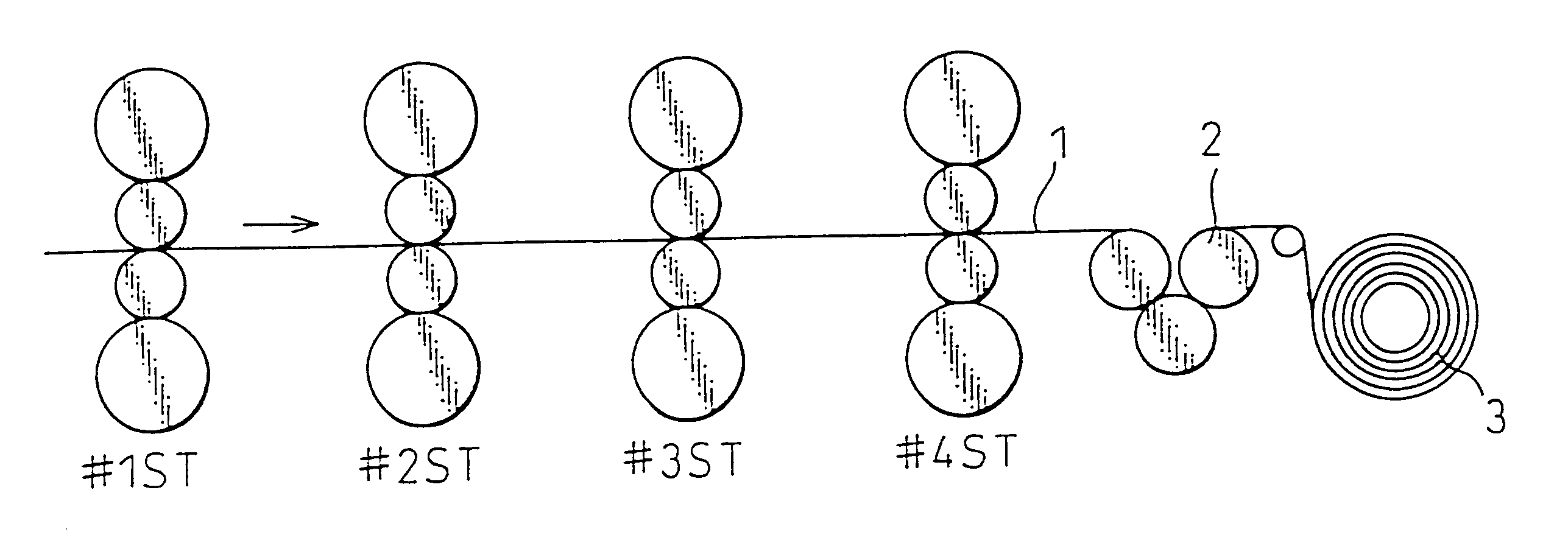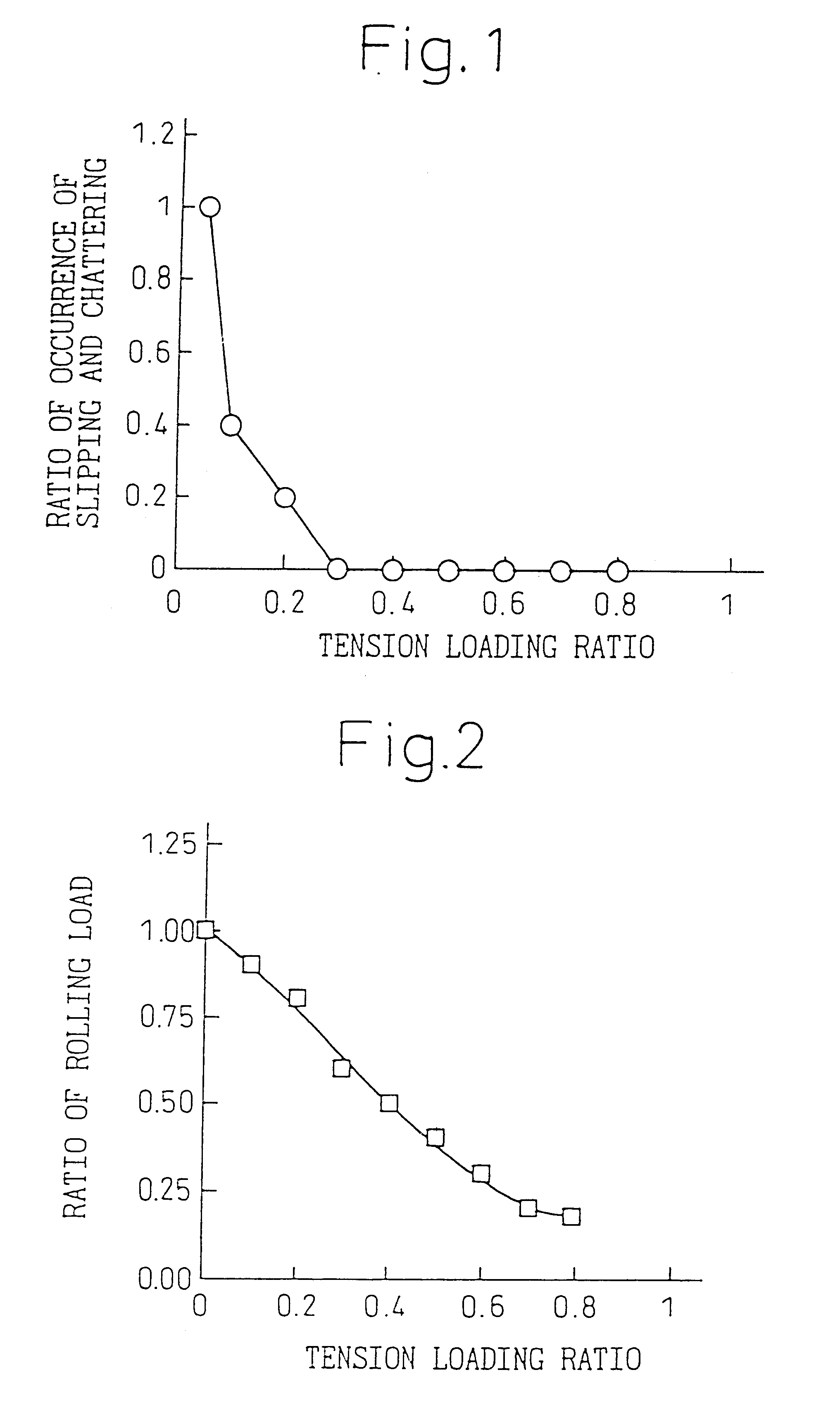Cold tandem rolling method and cold tandem rolling mill
a technology of cold tandem rolling and tandem rolling mill, which is applied in the direction of rolling mill control devices, manufacturing tools, profile control devices, etc., can solve the problems of increasing production costs, affecting the productivity of the product, and affecting the accuracy of sheet thickness temporarily, so as to prevent scratches without deteriorating productivity, raising production costs, and improving accuracy
- Summary
- Abstract
- Description
- Claims
- Application Information
AI Technical Summary
Benefits of technology
Problems solved by technology
Method used
Image
Examples
example 1
FIG. 5 is an overall arrangement view of the tandem cold rolling mill to which the present invention is applied. As illustrated in FIG. 5, the tandem cold rolling mill is composed of 4-high cold rolling stands, the number of which is 4. The rolling sheet (1) is rolled in each rolling stand and passes through the bridle rollers (2). Then the rolling sheet (1) is wound by the coiler (3). The rolling conditions are described as follows. In this connection, in the case where bridle rollers are provided and an intensity of rolling tension is 20 kgf / mm.sup.2, an intensity of tension between the delivery side of the rolling mill and the bridle rollers is 30 kgf / mm.sup.2, and an intensity of tension between the delivery side of bridle rollers and the coiler is 10 kgf / mm.sup.2. In the case where the bridle rollers are provided and an intensity of rolling tension is 0 kgf / mm.sup.2, an intensity of tension between the delivery side of the rolling mill and the bridle rollers is 30 kgf / mm.sup.2,...
example 2
In this example, the same tandem cold rolling mill, which was a 4-stand type 4-high tandem cold rolling mill, as that shown in FIG. 7 was used. The following are the rolling conditions of the fourth rolling stand at which heat scratches tend to occur on the surface of a rolled sheet.
Diameter of work roll (D): .PHI.480 mm
Speed of work roll (V.sub.R): 300 m / min
Tension on entry side (.sigma..sub.bs): 10 kgf / mm.sup.2
Tension on delivery side (.sigma..sub.fs): 5 kgf / mm.sup.2
Sheet thickness on entry side (H): 0.84 mm
Sheet thickness on delivery side (h): 0.60 mm
Sheet width (W): 988 mm
Thickness of material to be rolled (H.sub.s): 3.2 mm
Material: low carbon steel .sigma..sub.y =67(.epsilon.+0.03).sup.0.2 kgf / mm.sup.2
Lubrication of rolling: 2% emulsion of beef tallow (60.degree. C.)
In the process of rolling, when a large number of coils of the same size are rolled under the same rolling condition, the average temperature of the work roll is raised, and the sheet temperature on the delivery sid...
example 3
In order to make investigation into the effect of the present invention, the inventors made experiments using the same rolling mill and the same rolling conditions as those of Example 2. Conditions to restrict the tension were determined as follows. The entry side tension .sigma..sub.b =.sigma..sub.bs +.alpha., and the delivery side tension .sigma..sub.f =.sigma..sub.fs +.alpha. / 10. The maximum value .sigma..sub.bmax of tension on the entry side at which the sheet was not broken was set at 15 kgf / mm2, and the maximum value .sigma..sub.fmax of tension on the delivery side at which the sheet was not broken was set at 10 kgf / mm.sup.2.
FIGS. 9(a) and 9(b) are graphs showing the effect of the present invention. FIG. 9(a) shows a relation between the number of rolled coils and the tension on the entry side of the fourth rolling stand, and FIG. 9(b) shows a relation between the number of rolled coils and the work roller speed of the fourth rolling stand. Mark .quadrature. in FIGS. 9(a) and ...
PUM
| Property | Measurement | Unit |
|---|---|---|
| Fraction | aaaaa | aaaaa |
| Fraction | aaaaa | aaaaa |
| Fraction | aaaaa | aaaaa |
Abstract
Description
Claims
Application Information
 Login to View More
Login to View More - R&D
- Intellectual Property
- Life Sciences
- Materials
- Tech Scout
- Unparalleled Data Quality
- Higher Quality Content
- 60% Fewer Hallucinations
Browse by: Latest US Patents, China's latest patents, Technical Efficacy Thesaurus, Application Domain, Technology Topic, Popular Technical Reports.
© 2025 PatSnap. All rights reserved.Legal|Privacy policy|Modern Slavery Act Transparency Statement|Sitemap|About US| Contact US: help@patsnap.com



